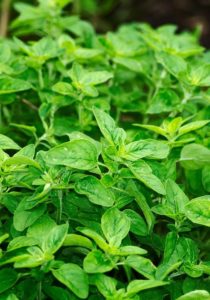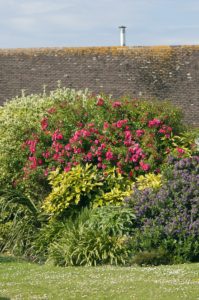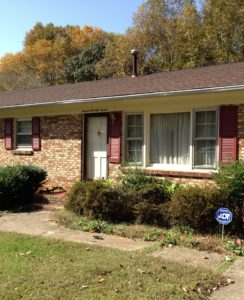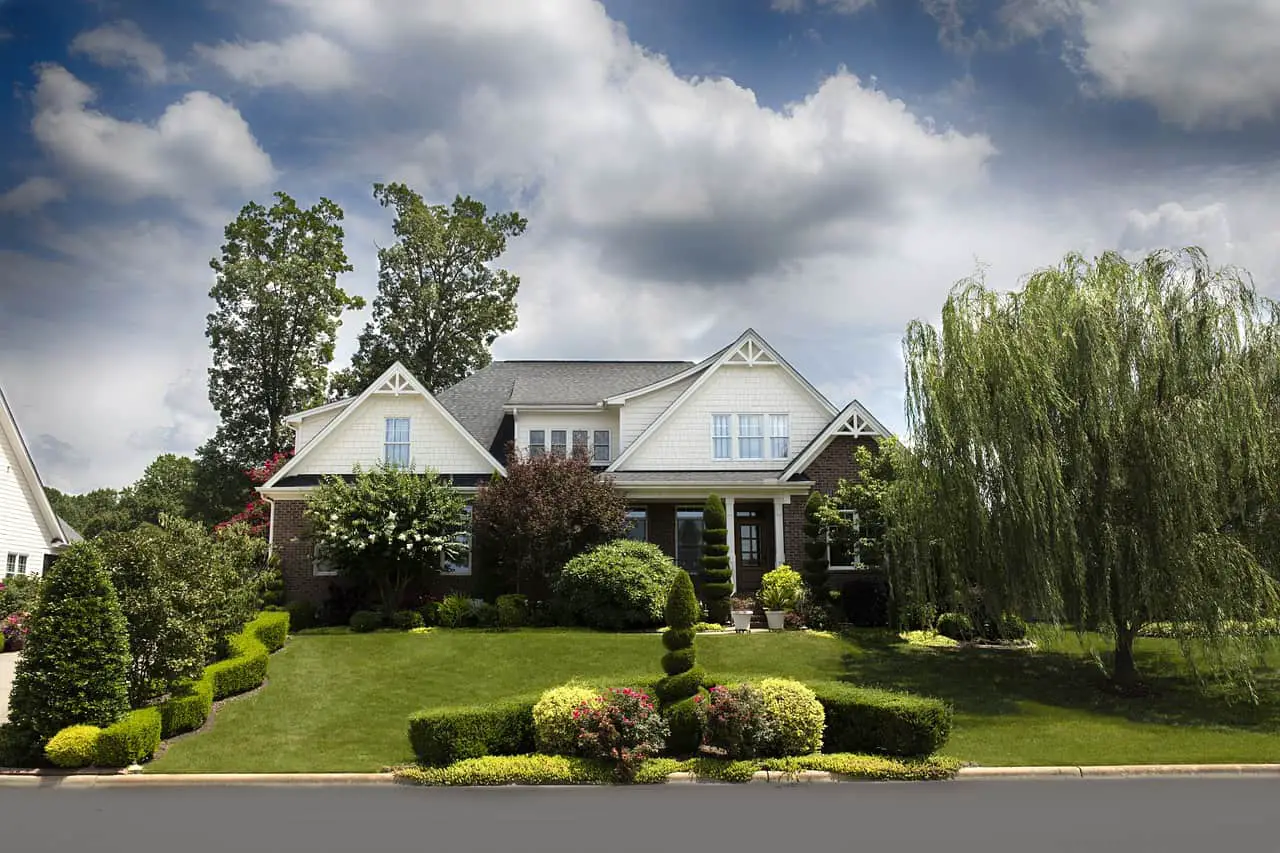Some links in the post are affiliate links and I get a commission from purchases made through some links found in the post.
Sometimes it seems that houses are being built bigger and bigger, while front gardens seen to be shrinking.
I remember when we had a huge front garden, but these days there seems to be less room for plants and more space for the house.
What I also notice is that sometimes the plants that are grown in smaller front gardens are simply not suitable.
They may have been cultivated for larger spaces and need a decent amount of area to grow to their full potential.
If left unattended, these plants can get out of hand rapidly. This can make the front of the garden look over run and untidy.
Fortunately, these days we have new varieties of plants that are meant to stay smaller and still bring curb appeal to our homes.
Low growing shrubs for the front of the house can look far better than an overgrown plant which just looks unkempt.
Look for Dwarf Varieties

If the front of your garden is small and compact, and you still want it to look attractive, then consider dwarf varieties of your favourite plants.
Dwarf shrubs take up less room, they also require less maintenance than large plants.
This means that you spend less time deadheading and pruning them. They normally attract fewer pests and have less issues with diseases.
Small shrubs are also easier to plant than large ones. You don’t need to heave the plant out of a huge container to get it into the ground.
You’ll never have to muscle a 5-gallon container into the right position and then get the plant into its hole!
Top 5 Low Growing Shrubs for Front of House
The following 5 are great low growing shrubs for ground cover.
1) Creeping Thyme
This low growing shrub will give you a display of tiny white or purple flowers towards the end of the spring. The creeping thyme spreads well and thrives in full sunlight.
Even better, it tolerates the cold well, grows in bad soil and once it is established, does well in drought conditions. You can even trim some leaves to use in the kitchen!
2) Purple Sage
Both the leaves and the flowers are edible with this plant. It will spread to about 1 meter and grow to around 80cm high.
If you prune the plant after it has flowered it will stay bushier. You can get more plants by taking cuttings and propagating them.
3) Nandina Domestica Firepower
This plant will grow in sun or partial shade and looks best when planted in a group with other plants.
The leaves turn bright red and copper in the fall, while in mid-summer it produces small white flowers.
This plant does not mind the soil type and is also frost hardy unless very cold for long periods of time.
4) Creeping Juniper
This is one of those plants that you pop in and forget about. Its tough once it is established and comes in several shapes and sizes.
The creeping branches make a weed free mat. Once the plant is established it will tolerate drought conditions. It loves the sun!
5) Oregano
You may have thought this was only used in the kitchen garden, but in fact it makes a great ground cover shrub.
It develops dense clumps of leaves which smell divine.
Oregano has small flowers in summer and loves full sunlight.
And yes, you can cut some off to cook with, or even to keep it at a height you like.
You may also like: How to use an arborvitae in your landscaping
What are the Best Small Flowering Shrubs for the Front of Your House?
1) Azalea
These are one of my favourite shrubs. They come in beautiful shades of purple, coral, pink, peach and white.
They work great when planted in a group. Azaleas are both evergreen and deciduous (where they drop their leaves in winter) so look at the label before you buy.
2) Dwarf Rhododendron
The dwarf rhododendron is a very hardy plant and does not grow higher than about 3 ft. They are ideal for containers or small gardens.
Perfect for growing along the driveway. They are hardy and will flower well every spring. They will do well in either full sun or partial shade.
3) Abelia
Once established this plant is hardy against the cold weather.
It develops lovely flowers in pink, peach and purple.
It gives off a delicate sweet/spice fragrance which you will notice most in the early evenings.
4) Caryopteris
Butterflies and bees love this plant which will develop brilliant blue flowers late in summer.
This makes them ideal for when other plants are starting to lose their flowers as that is when they will start flowering. They love full sun and do well when planted in a group.
5) Hydrangea Flare
This plant will grow to just 3 ft high and about that wide so ideal for small spaces. The flowers are cone-shaped and white, turning to red/pink.
These hydrangea flare plants enjoy at least 6 hours of sun a day and if they have this condition they will reward you with heaps of flowers every year. They are also tolerant to -40 degrees F.
Where to Plant Shrubs in Front of Your House?
 This is a good question and people can often get it wrong, planting shrubs in places where they are simply not suitable or do not do well.
This is a good question and people can often get it wrong, planting shrubs in places where they are simply not suitable or do not do well.
Shrubs in the front of your house can be referred to as foundation plants. They enhance the entrance and even add value to you home.
They give a house ‘curb appeal’ and make it look a welcoming place.
Many years ago, the most common plants to plant around the front of the house were stiff evergreens which did little to make the house more inviting.
You may want to avoid having any large shrubs close to the windows. This is because they may invite bees and other insects into the house in the summer months.
Before you start planting low growing shrubs in front of your house, you should consider the shape of the house. This will dictate which plants you choose and where to plant them.
Formal Homes
These are like the pictures we would draw as children – a house with a centre door and symmetrical windows on either side. If your house looks like this then you may try to more formal types of plants.
Mirror imaged plants often look attractive with this style of house. You should avoid plants that block the view of your house, as well as staying away from lone beds in the centre of the lawn.
Shrubs placed at the corners of the house will give it a softer look while also giving the appearance that the house is larger than it really is.
In a formal garden setting a garden path can be lined with similar plants which lead up to the front door and are kept well-trimmed and neat.
Cottage Homes
This style of house benefits from asymmetrical plant arrangements and more casual designs.
The area around the front door will be a focal point so can be filled with colourful shrubs in interesting shapes.
Bare walls can have a trellis work area where plants cover the wall and grow more upwards rather than just in shrub form.
In both house styles it is worth keeping the windows plant free so as not to cut off light to the inside.
Tiny Front Gardens
Houses with minute front gardens will be better suited to having an array of pot plants rather than any grown in soil.
Not only are pots easier to move around but they are also easy to refill and keep small rather than spread and need to be pruned back every year.
It is possible to grow small trees in front of the house but bear in mind that they may eventually need to be planted in the ground and may be too large for the tiny garden.
Final Thoughts: Top 5 Low Growing Shrubs for Front of House
 Low growing shrubs for the front of the house can be a challenge. It is easy to plant a small shrub without knowing how large it’ll grow.
Low growing shrubs for the front of the house can be a challenge. It is easy to plant a small shrub without knowing how large it’ll grow.
Unfortunately, many plants are removed because they are just not suitable for the spot they are placed in.
It is worth paying a visit to your garden centre to see what plants they have for specific areas of the garden.
Most plants are categorised by size and spread so you will have a good idea of how big the full-grown plant will be.
No matter how tempting it may be to buy that full-size geranium, be sure that you have enough space for it to reach its full growth size before you part with money.
Plants that become too big for the spot will not do well. They may even die because they are in a constant battle with others for food.
It pays to buy plants that suit the place you plan to use, rather than buying plants because they are cheap or look pretty.
A little bit of research will show you the right plants for the right spot and you will enjoy them for many years to come.
Before you go, here are some more related articles I encourage you to read below to help solve more of your gardening issues:
How To Landscape With Potted Plants
How Long Do I Have To Wait Before Planting After Stump Grinding?
Written by: Valerie Holyoak

